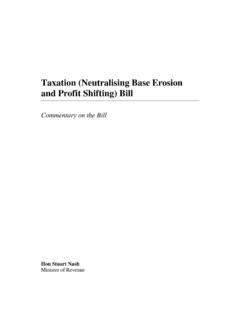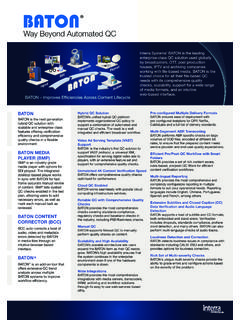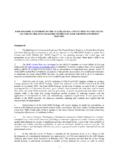Transcription of Organic-inorganic sol-gel coating for corrosion protection ...
1 JOURNAL OF MATERIALS SCIENCE LETTERS21, 2002, 251 255 Organic-inorganic sol-gel coating for corrosion protectionof stainless steelT. P. CHOUD epartment of Materials Science and Engineering, University of Washington, Seattle, WA, USAC. CHANDRASEKARANB oston Scientific Northwest Technology Center, Redmond, WA, USAS. LIMMER, C. NGUYEN, G. Z. CAOD epartment of Materials Science and Engineering, University of Washington, Seattle, WA, USAE-mail: of the most effective corrosion control techniquesis the electrical isolation of the anode from the cath-ode [1, 2]. The chromium oxide (Cr2O3) passivationlayer formed on the surface of stainless steel in oxi-dizing environments is one example. This is the mainreason for the durability and corrosion resistance be-havior of this particular metal [2, 3].
2 A more genericapproach to enhance corrosion resistance is to applyprotective films or coatings. Through the modificationof chemical composition of the coatings, such protec-tive coatings can also permit the introduction of otherdesired chemical and physical properties, such as me-chanical strength and hydrophobicity. Various organiccoatings have been studied for corrosion protection [4 6]. Specifically, various oxide coatings by sol-gelprocessing have been studied extensively for corrosionprotection of stainless steel [9 13]. In spite of all theadvantages of sol-gel processing, sol-gel oxide coatingssuffer from several drawbacks. In general, sol-gel coat-ings are highly porous with low mechanical integrity;annealing or sintering at high temperatures (>800 C)is required to achieve a dense microstructure [14 17].
3 Consequently, sintering at high temperatures might in-troduce cracks and/or delamination of sol-gel coatingsdue to a large mismatch of thermal expansion coeffi-cients and possible chemical reactions at the at high temperatures also limits applicationof sol-gel coatings on temperature sensitive substratesand viable approach to dense, sol-gel -derived coat-ings without post-deposition annealing at elevated tem-peratures is to synthesize Organic-inorganic hybridcoatings. When appropriate chemical composition andprocessing conditions are applied, relatively denseorganic- inorganic hybrid coatings can be developed forapplications, including wear resistance [18, 19] and cor-rosion protection [20 22]. Messaddeqet al.
4 [21] stud-ied corrosion resistance of Organic-inorganic hybridcoatings on stainless steel. The coatings were made bydispersing various amounts of polymethylmethacrylate(PMMA) into zirconia (ZrO2) sol and fired at 200 C for30 min. PMMA-ZrO2coatings demonstrated promis-ing corrosion resistance and increased the lifetimeof the stainless steel by a factor 30 [21]. However,phase segregation, incomplete coverage, and delami-nation were observed when the coatings consisted ofa high content of organic components. In this paper,we studied the corrosion resistance of sol-gel -derived, Organic-inorganic hybrid single-layer coatings ontwo types of stainless steel. sol-gel -derived coatingswere made from tetraethylorthosilicate (TEOS) and3-methacryloxypropyltrimethoxysilane (MPS) using atwo-step acid catalysis process, and were annealed at300 C for 30 min.
5 It was demonstrated that sol-gel de-rived hybrid coatings could significantly enhance thecorrosion protection of both 304 and 316 stainless steelsubstrates. Furthermore, the corrosion resistance be-havior of the hybrid coatings on both types of stainlesssteel was compared and possible mechanisms were silica-based Organic-inorganic hybrid sol wasprepared with an acid-catalyzed, two-step hydrolysis-condensation process. The hybrid sol was preparedby admixing a silica precursor, tetraethylorthosili-cate (TEOS, Si(OC2H5)4), and an organic component,3-methacryloxypropyltrimethoxy silane (MPS, H2CC(CH3)CO2(CH2)3Si(OCH3)3), to control the flexibi-lity and density of the sol-gel network. Silica (SiO2)sol containing 10 mol% MPS with a TEOS : MPS ratioof 90 : 10 was used for analysis.
6 An initial stock solu-tion was made by adding amounts of TEOS and MPSin a mixture of ethanol (C2H5OH), deionized water(DI H2O), and 1N hydrochloric acid (HCl), resulting ina TEOS : MPS : C2H5: DI-H2O : HCl nominal molarratio of : : :5 10 3. The mixturewas vigorously stirred at a rate of 500 RPM for90 min at a temperature of 60 C, and further process-ing of the sol required an additional mL 1N HCland mL DI H2O to 30 mL of the stock sol was stirred again at a rate of 500 RPM for60 min at a temperature of 60 C. Ethanol was addedto dilute the sol in order to obtain a volume ratio of2 : 1 ethanol to substrates (10 mm 40 mm in dimension) usedfor the analysis of the sol-gel coatings were 304 and 316stainless steel that had been electropolished.
7 The expo-sure of the substrates to nitric acid (HNO3) decreasedthe iron content and increased the chromium content0261 8028C 2002 Kluwer Academic Publishers251at the surface. In order to ensure a tight bond and goodadhesion between the substrate surface and the sol-gelcoating, the substrates were exposed to surface hy-droxylation at an elevated temperature. Each substratewas initially rinsed with DI H2O, cleaned with ethanol,and air-dried. The substrates were then immersed forapproximately 30 min into a 90 C solution mixtureof 30% hydrogen peroxide (H2O2) and concentratedsulfuric acid (H2SO4) with a 30 : 70 volume ratio. A DIH2O rinse was used to wash excess solution remainingand the substrates were then stored in DI H2O solutionto preserve the hydroxyl groups on the surface.
8 Using adip-coater (Chemat Technology Inc, model 201), eachsubstrate was dipped into the sol at a constant speed of140 mm/min, immersed into the sol for 1 min, and thenwithdrawn at approximately the same speed. The coat-ing was air-dried for approximately 1 min and placed ina furnace to initiate post-deposition heat treatment. Thesingle-layer coated substrates were annealed at 300 Cfor approximately 30 min at a heating and cooling rateof 5 C/min. This low temperature annealing processallowed for the preservation of the organic componentand the reduction of possible crack formation inthe sol-gel coatings due to the difference in thermalexpansion coefficients of silica and stainless measurements were performed under extreme en-vironmental conditions consisting of an aqueous, air-exposed, saturated sodium chloride (32% NaCl) solu-tion.
9 Each sample was sealed with resistant adhesivetape in order to prevent premature corrosion along theedges of the substrate. A mm 10 mm area withinthe center of each sample was exposed to the solutionduring testing. corrosion analysis of bare and coatedsubstrates was done using a potentiostat (EG&G Instru-ments Inc, model 273) connected to a corrosion analysissoftware program (EG&G Princeton Applied Research,model 352/252, version ). Polarization measure-ments were carried out potentiostatically at room tem-perature using a saturated calomel reference electrode(SCE) and a platinum counter electrode. The poten-tiodynamic measurements were taken within the rangeof 1000 mV to 1200 mV versus SCE at a rate of2 mV/s.
10 Prior to the measurements, each sample wasimmersed in 32% NaCl solution for at least 15 microscopy and scanning electron microscopy(SEM) were also performed on the bare and coatedsubstrates to characterize the surface morphology. El-lipsometer with a He-Ne laser ( = nm) was usedto determine the relative density and thickness of thesol-gel-derived coatings on silicon microscopy and SEM and ellipsometry anal-yses revealed that uniform, homogeneous, and crack-free hybrid sol-gel coatings on stainless steel substrateswere readily obtained prior to and after post-depositionannealing at 300 C for 30 min. The corrosion protec-tion properties of sol-gel derived coatings are stronglydependent on the processing conditions.






